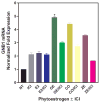Phytoestrogens regulate mRNA and protein levels of guanine nucleotide-binding protein, beta-1 subunit (GNB1) in MCF-7 cells
- PMID: 19170076
- PMCID: PMC4547522
- DOI: 10.1002/jcp.21699
Phytoestrogens regulate mRNA and protein levels of guanine nucleotide-binding protein, beta-1 subunit (GNB1) in MCF-7 cells
Abstract
Phytoestrogens (PEs) are non-steroidal ligands, which regulate the expression of number of estrogen receptor-dependent genes responsible for a variety of biological processes. Deciphering the molecular mechanism of action of these compounds is of great importance because it would increase our understanding of the role(s) these bioactive chemicals play in prevention and treatment of estrogen-based diseases. In this study, we applied suppression subtractive hybridization (SSH) to identify genes that are regulated by PEs through either the classic nuclear-based estrogen receptor or membrane-based estrogen receptor pathways. SSH, using mRNA from genistein (GE) treated MCF-7 cells as testers, resulted in a significant increase in GNB1 mRNA expression levels as compared with 10 nM 17beta estradiol or the no treatment control. GNB1 mRNA expression was up regulated two- to fivefold following exposure to 100.0 nM GE. Similarly, GNB1 protein expression was up regulated 12- to 14-fold. GE regulation of GNB1 was estrogen receptor-dependent, in the presence of the anti-estrogen ICI-182,780, both GNB1 mRNA and protein expression were inhibited. Analysis of the GNB1 promoter using ChIP assay showed a PE-dependent association of estrogen receptor alpha (ERalpha) and beta (ERbeta) to the GNB1 promoter. This association was specific for ERalpha since association was not observed when the cells were co-incubated with GE and the ERalpha antagonist, ICI. Our data demonstrate that the levels of G-protein, beta-1 subunit are regulated by PEs through an estrogen receptor pathway and further suggest that PEs may control the ratio of alpha-subunit to beta/gamma-subunits of the G-protein complex in cells. J. Cell. Physiol. 219: 584-594, 2009. (c) 2009 Wiley-Liss, Inc.
Figures






Similar articles
-
Estrogen receptor-dependent regulation of CYP2B6 in human breast cancer cells.Biochim Biophys Acta. 2010 May-Jun;1799(5-6):469-79. doi: 10.1016/j.bbagrm.2010.01.005. Epub 2010 Jan 14. Biochim Biophys Acta. 2010. PMID: 20079471 Free PMC article.
-
Expression of differentiation-associated gene icb-1 is estrogen-responsive in ovarian and breast cancer cell lines.J Steroid Biochem Mol Biol. 2008 Mar;109(1-2):16-21. doi: 10.1016/j.jsbmb.2007.12.007. Epub 2007 Dec 7. J Steroid Biochem Mol Biol. 2008. PMID: 18206364
-
Quantitative proteomics and transcriptomics addressing the estrogen receptor subtype-mediated effects in T47D breast cancer cells exposed to the phytoestrogen genistein.Mol Cell Proteomics. 2011 Jan;10(1):M110.002170. doi: 10.1074/mcp.M110.002170. Epub 2010 Sep 30. Mol Cell Proteomics. 2011. PMID: 20884965 Free PMC article.
-
Modulation of estrogen receptor-beta isoforms by phytoestrogens in breast cancer cells.Int J Oncol. 2006 May;28(5):1185-91. Int J Oncol. 2006. PMID: 16596234
-
Dynamic regulation of estrogen receptor-alpha gene expression in the brain: a role for promoter methylation?Front Neuroendocrinol. 2008 Jun;29(3):375-85. doi: 10.1016/j.yfrne.2008.03.002. Epub 2008 Mar 13. Front Neuroendocrinol. 2008. PMID: 18439661 Free PMC article. Review.
Cited by
-
Hydrogen peroxide initiates oxidative stress and proteomic alterations in meningothelial cells.Sci Rep. 2022 Aug 25;12(1):14519. doi: 10.1038/s41598-022-18548-3. Sci Rep. 2022. PMID: 36008468 Free PMC article.
References
-
- Adlercreutz H, Bannwart C, Wahala K, Makela T, Brunow G, Hase T, Arosemena PJ, Kellis JT, Jr, Vickery LE. Inhibition of human aromatase by mammalian lignans and isoflavonoid phytoestrogens. J Steroid Biochem Mol Biol. 1993;44(2):147–153. - PubMed
-
- Ahn CH, Jeong EG, Lee JW, Kim MS, Kim SH, Kim SS, Yoo NJ, Lee SH. Expression of beclin-1, an autophagy-related protein, in gastric and colorectal cancers. Apmis. 2007;115(12):1344–1349. - PubMed
-
- Allred CD, Ju YH, Allred KF, Chang J, Helferich WG. Dietary genistin stimulates growth of estrogen-dependent breast cancer tumors similar to that observed with genistein. Carcinogenesis. 2001;22(10):1667–1673. - PubMed
-
- Ansonoff MA, Etgen AM. βββ elevates protein kinase C catalytic activity in the preoptic area of female rats. Endocrinology. 1998;139(7):3050–3056. - PubMed
MeSH terms
Substances
Grants and funding
LinkOut - more resources
Full Text Sources

